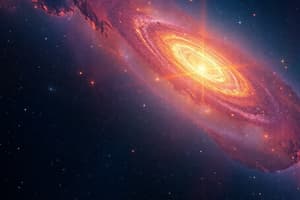Podcast
Questions and Answers
What is formed as a result of the collapse of a giant molecular cloud?
What is formed as a result of the collapse of a giant molecular cloud?
- Asteroids
- Black holes
- Galaxies
- Stars (correct)
Which process follows the formation of a disc around a star in the protoplanet hypothesis?
Which process follows the formation of a disc around a star in the protoplanet hypothesis?
- Formation of planidisimals (correct)
- Formation of neutron stars
- Formation of asteroids
- Formation of black holes
What significant event immediately precedes Big Bang nucleosynthesis?
What significant event immediately precedes Big Bang nucleosynthesis?
- Formation of galaxies
- Rapid exponential inflation (correct)
- Cooling period of the universe
- Creation of dark energy
What dominated the universe after the matter-dominated period according to the evolution of the universe?
What dominated the universe after the matter-dominated period according to the evolution of the universe?
Which element was NOT a product of Big Bang nucleosynthesis?
Which element was NOT a product of Big Bang nucleosynthesis?
Flashcards are hidden until you start studying
Study Notes
Solar Nebular Disc Model
- Stars originate from the collapse of a giant molecular cloud composed of gas and dust.
- The collapse results in the coalescence of smaller clumps that lead to the formation of a spinning disc around a central protostar.
- Planets emerge as a byproduct of stellar formation within this disc.
Protoplanet Hypothesis
- As gas and dust accumulate, a disc forms around a new star, containing minute particles.
- This disc leads to the creation of planetesimals—small bodies that can collide and merge.
- The collisions of planetesimals result in the formation of protoplanets, which eventually evolve into the planets we know today.
- The hypothesis is reinforced by contemporary understanding of fluid dynamics, chemistry, and advancements in astronomy.
Evolution of the Universe
- The universe began as an incredibly hot, dense state commonly referred to as a "tiny star."
- A rapid period of exponential inflation occurred, giving rise to fundamental particles such as quarks, hadrons, and leptons.
- Big Bang nucleosynthesis resulted in the formation of the first atomic nuclei, primarily hydrogen, helium, and lithium, during a cooling phase.
- Following the initial cooling, the universe transitioned into a matter-dominated era marked by the aggregation of stars, clouds, and galaxies, fostering the creation of heavier elements.
- Eventually, dark energy became the dominant force, leading to the accelerated expansion of the universe.
- It is within this context of cosmic evolution that the solar system formed.
Studying That Suits You
Use AI to generate personalized quizzes and flashcards to suit your learning preferences.




